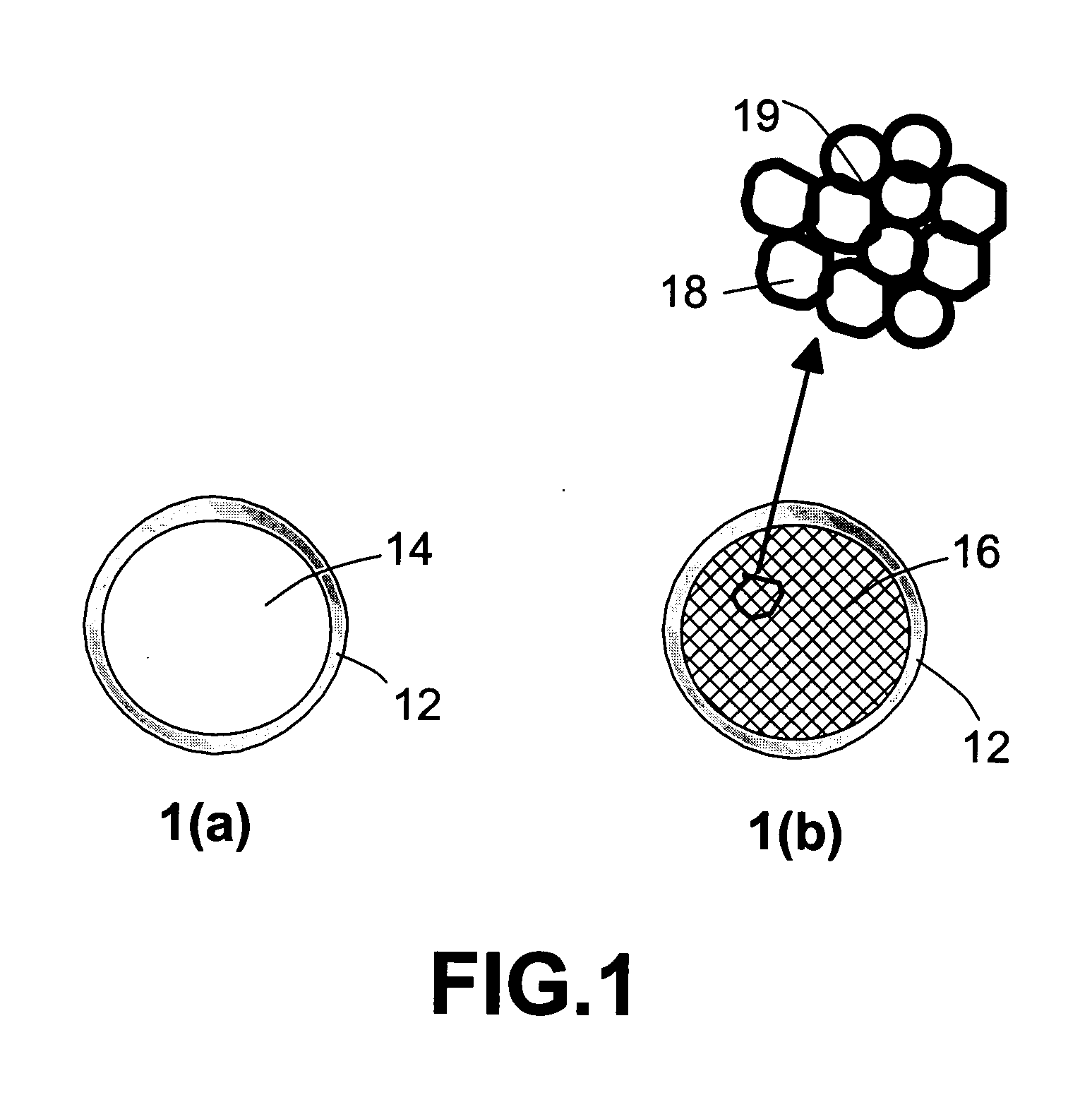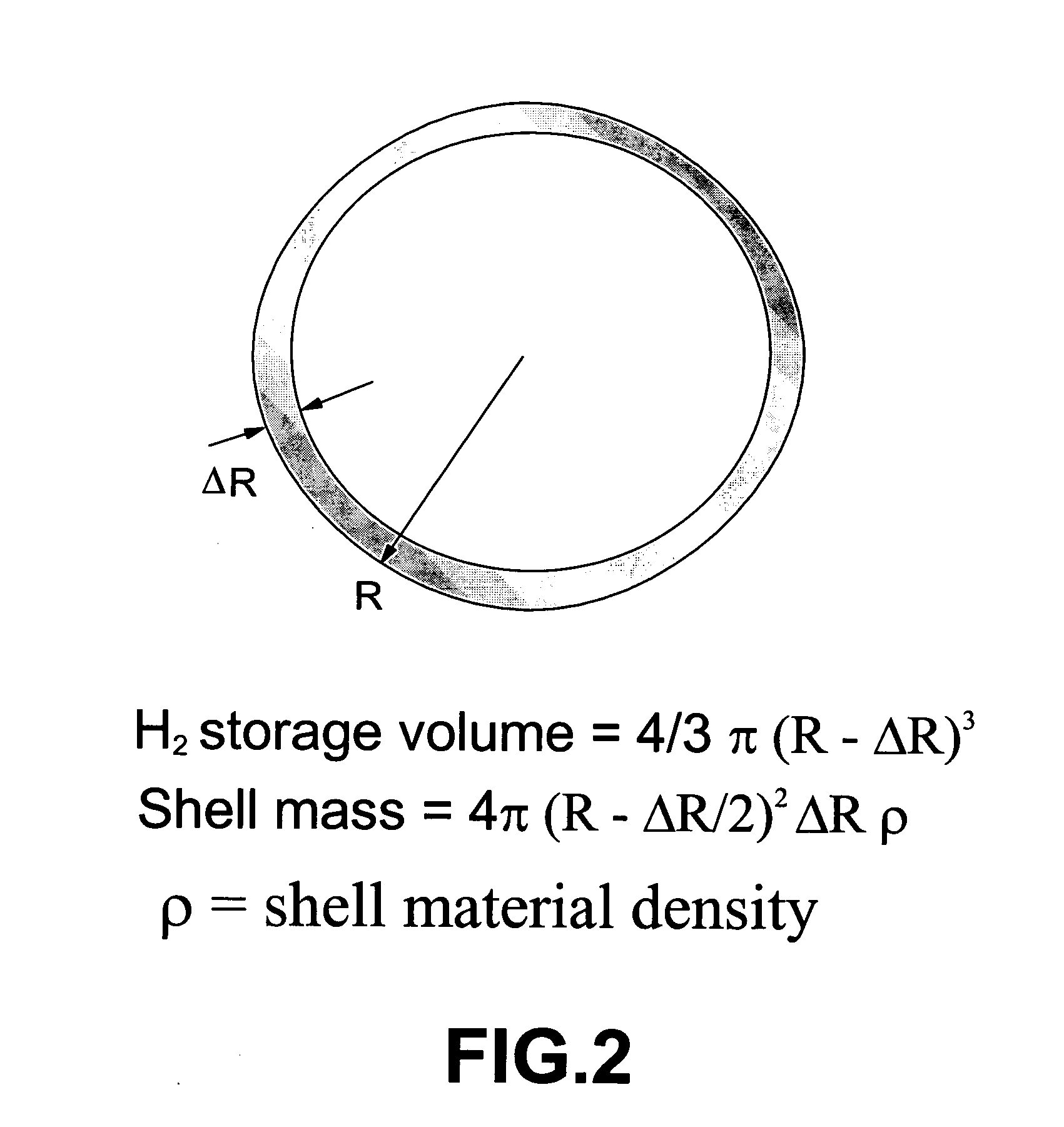Method for storing and delivering hydrogen to fuel cells
a fuel cell and hydrogen storage technology, applied in the direction of electrical generators, sustainable buildings, mechanical equipment, etc., can solve the problems of high cost, unsafe, unportable, etc., and achieve the effect of reducing the tensile strength of the shell, effective release of hydrogen gas, and high tensile strength
- Summary
- Abstract
- Description
- Claims
- Application Information
AI Technical Summary
Benefits of technology
Problems solved by technology
Method used
Image
Examples
example 1
From Expandable Polystyrene Beads
[0044] The production procedures for foamed plastics are adapted herein for the preparation of porous core-solid shell plastic beads. Micrometer-sized polystyrene (PS) beads were subjected to a helium gas pressure of approximately 7 atm and a temperature near 90° C. (inside a pressure chamber) for two hours, allowing helium gas molecules to diffuse into PS beads. The chamber was then cooled down to room temperature under a high helium gas pressure condition to seal in the gas molecules. These gas-filled beads were then placed in an oven preset at 110° C., allowing the supersaturated gas molecules to try to diffuse out and, thereby, producing micro-porous PS beads or “foamed” beads that have a thin solid skin. An optical microscopy study of several cross-sections of the shell structure of foamed plastic beads reveal bi-axial orientation of polymer chains, which were formed presumably due to the bi-axial tensile stress experience by the skin portion o...
example 2
Polymer Hollow Spheres
[0045] A 5-liter round bottomed flask was equipped with paddle stirrer, thermometer, nitrogen inlet and reflux condenser. To 2080 g of deionized water heated to 80° C. was added 5.5 g of sodium persulfate followed by 345 g of an acrylic polymer dispersion (40% solids) with an average particle size of 0.3 micron as the seed polymer. A monomer emulsion consisting of 55.5 g of butyl acrylate, 610.5 g of methyl methacrylate and 444 g of methacrylic acid in 406 g of water and 20 g of sodium dodecyl benzene sulfonate (23%) was added over a 2 hour period. This resulting alkali swellable core is used as the seed polymer for the following reaction:
[0046] To an identical 5-liter kettle (now empty) is added 675 g of water. After heating to 80° C., 1.7 g of sodium persulfate followed by 50.5 g (1 part by weight solids) of the above alkali swellable core is added. A monomer emulsion (9 parts by solids) consisting of 110 g of water, 0.275 g of sodium dodecylbenzene sulfona...
examples 3-a and 3-b
[0052] Two exemplary compositions are expressed in mole percent on the oxide basis as calculated from the batch, wherein BaO and ZnO additives were included in the base P2O5—Ag2O—X system, wherein X is selected from the group of Cl, Br, and I. The glasses were prepared in the following manner. Appropriate amounts of AgNO3 and H3PO4 were blended together and the mixture heated to about 200° C., at which time the AgNO3 melted and a clear, colorless, homogeneous solution resulted. Upon further heating, (e.g., up to 500° C.), water and nitrogen oxide fumes were evolved. The resulting melt was heated to about 700° C. and held at that temperature for about one hour to insure removal of water and the nitrogen oxides. A AgPO3 glass was formed by pouring the melt onto a stainless steel block. The glass was annealed at 160° C. An appropriate amount of a silver halide was then mixed with a comminuted sample of the AgPO3 glass and the mixture fused at about 450° C. The additives were then disso...
PUM
| Property | Measurement | Unit |
|---|---|---|
| Tm | aaaaa | aaaaa |
| diameter | aaaaa | aaaaa |
| diameter | aaaaa | aaaaa |
Abstract
Description
Claims
Application Information
 Login to View More
Login to View More - R&D
- Intellectual Property
- Life Sciences
- Materials
- Tech Scout
- Unparalleled Data Quality
- Higher Quality Content
- 60% Fewer Hallucinations
Browse by: Latest US Patents, China's latest patents, Technical Efficacy Thesaurus, Application Domain, Technology Topic, Popular Technical Reports.
© 2025 PatSnap. All rights reserved.Legal|Privacy policy|Modern Slavery Act Transparency Statement|Sitemap|About US| Contact US: help@patsnap.com



